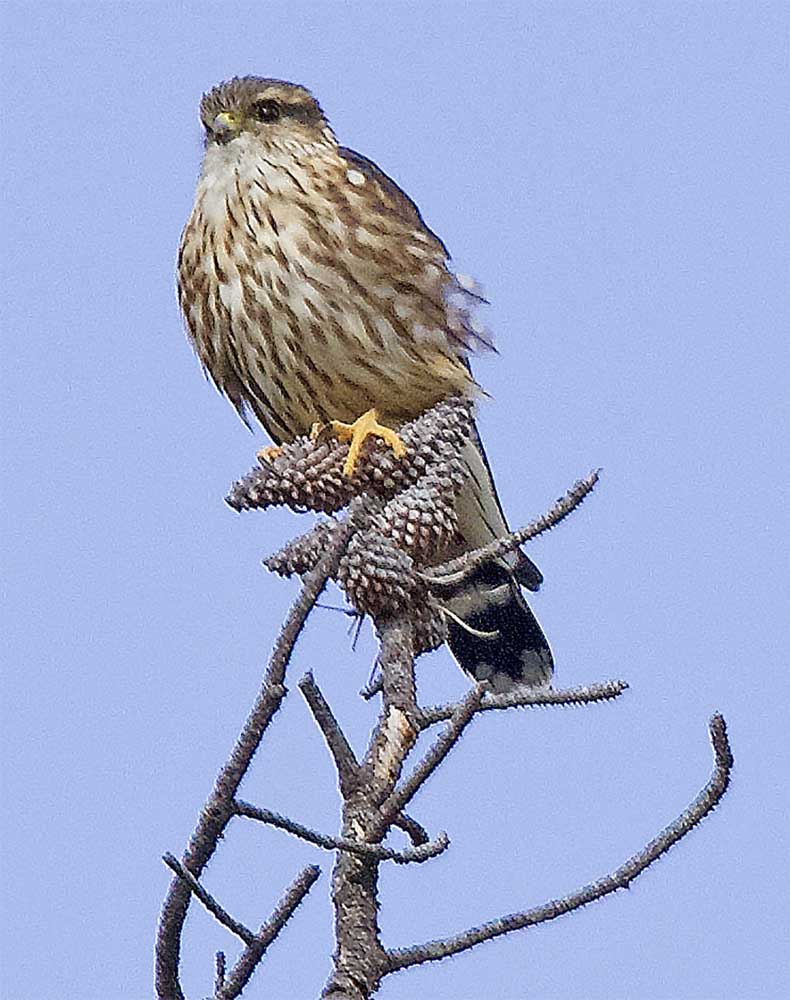Birding: Raptors face global decline, but some healthy here
Published 8:51 am Thursday, October 28, 2021

- The merlin is one of the falcons that should be seen on the raptor survey. It is small hawk close in size to the American kestrel.
Birds of prey or raptors are in decline worldwide. The bald eagle population is an exception due to its dramatic comeback in North America.
Trending
November marks the beginning of the raptor survey. Susan Stauffer and I will be surveying the Long Beach Peninsula at least once a month for the presence of raptors from November 2021 until March 2022. November and March will capture migration, while December through February will capture birds of prey that are our winter residents. The two of us will count them, take photos, and report our findings to the coordinator, Jeff Fleischer.
The East Cascades Audubon Society in Bend, Oregon sponsors the raptor survey. It is designed to look at population levels, distribution and densities of raptor species in the project area during the winter months. In addition, raptor survey data are given to “The Peregrine Fund” so they can augment their “ever-increasing data base for all species of birds of prey around the world,” Fleischer said.
We will be watching for buteos such as the red-tailed hawk, red-shouldered hawk and rough-legged hawk. Falcons we hope to see include the American kestrel, merlin and peregrine. Cooper’s hawk, sharp-shinned hawk and the northern goshawk are included in the accipiter category. Owls are also raptors that are included in the survey, along with the northern harrier, bald eagle, golden eagle and osprey. It is an impressive list. It will be interesting to see which species depend on our area during the colder months.
Trending
The Columbian newspaper in August reported on The International Union for the Conservation of Nature and Birdlife International’s data analysis concerning the state of the raptors worldwide.
The following is a summary of the report’s findings, and comments by some scientists and researchers on the findings. The study indicates that of the 557 raptor species, 30% are considered to be near threatened, vulnerable or endangered. More specifically, researchers found that birds of prey that are most active during the daylight hours such as most hawks, eagles and vultures were declining, and nearly half of nocturnal raptors such as owls were also declining.
Scientist Evan Buechley, a researcher at the Smithsonian Migratory Bird Center and Hawk Watch International, indicates that the biggest threats on a global level are climate change, loss of habitat and toxic substances. DDT is one example from the past that threatened raptors such as the bald eagle. The DDT ban in 1972 resulted in the come-back of the bald eagle. However, Buechley argues that bullets and pellets typically used by hunters that contain some lead, and certain pesticides including rodent pesticides, are among some of the other factors contributing to the decline in our raptor population — mainly because many of them feast on the meat of dead things.
The question is how are we doing in Washington state? Peninsula data will only have been collected for three years so it won’t be possible to see a definitive trend yet. However, The Peregrine Fund (PF)has analyzed the data from the raptor survey we are a part of. Fleischer has looked at the analysis for the state. He suggests that the data reveal a decline in two species — the rough-legged hawk and the northern harrier — but increases are evident for the American kestrel, red-shouldered hawk, red-tailed hawk and the bald eagle. I will examine this year’s winter data sometime in March to see whether a pattern is beginning to show up for the Long Beach Peninsula.
The Peregrine Fund (peregrinefund.org) added to the traditional list of issues affecting the population of birds of prey mentioned above. They are energy supply (wind facilities), invasive plant species, and human conflict, i.e. the shooting of raptors. The PF website provides details on the six issues faced by our birds of prey. You can find the discussion and more at the website above.
Raptors are fascinating birds. The PF defines them as birds with keen vision, curved beaks and sharp talons. Watch for them during the king tide days. They will be out in force. Happy birding!









